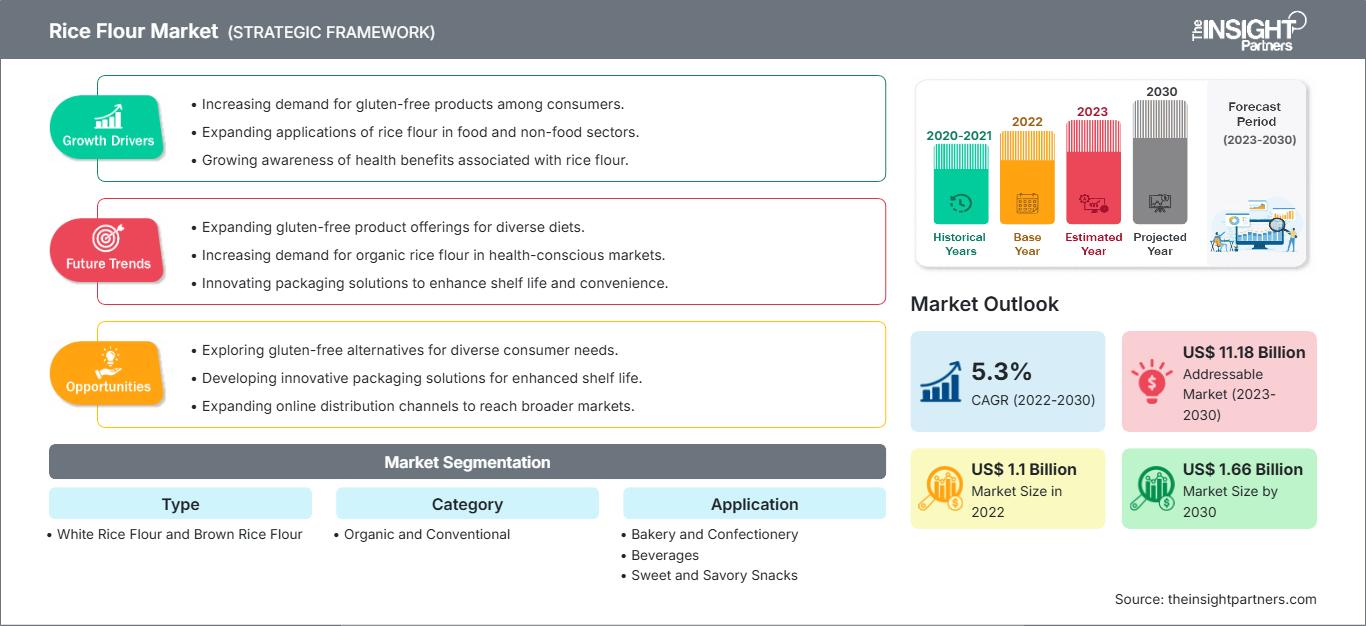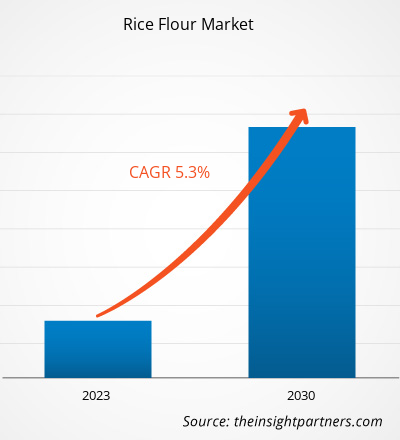[調査レポート] 米粉市場規模は2022年に11億47万米ドルと評価され、2030年までに16億5,582万米ドルに達すると見込まれています。また、2023年から2030年にかけて5.3%のCAGRで成長すると予測されています。
市場分析とアナリストの見解:
米粉は、米粒を粗い粉と細かい粉に挽いて作られます。米粉はグルテンを含まないため、小麦粉の代用として使用されています。消費者の健康への関心の高まりとグルテンフリーの食事に対するニーズの高まりが、米粉市場の成長を後押ししています。米粉には、消化管の改善、骨格の健康増進、創傷治癒の促進、セリアック病患者への効果など、さまざまな健康効果があります。米粉はビタミンCが豊富で、肌の修復に必要な抗酸化物質を含んでいます。玄米にはビタミンB群、高タンパク質、そしてより多くの食物繊維と抗酸化物質が含まれていますが、白米はカロリーの低い食品です。米粉の栄養価の高さは、様々な食品・飲料メーカーの間で米粉の需要を高めています。米粉は、パンや菓子、甘味・塩味のスナック、飲料、ベビーフードなど、多くの食品に使用されている健康的な原料です。米粉には、中粒・短粒、長粒、アルファ化の3種類があります。
成長の原動力と課題:
米粉は、パンや菓子、甘味・塩味のスナック、飲料、ベビーフードなど、多くの食品に使用されている健康的な原料です。米粉には、中粒・短粒、長粒、アルファ化の3種類があります。米粉はビタミンCが豊富で、肌の修復に必要な抗酸化物質を含んでいます。玄米は米粉の一種で、ビタミンB群、高タンパク質、食物繊維、抗酸化物質を豊富に含みます。一方、白米はカロリーの低い食品です。玄米の栄養価の高さは、様々な食品・飲料メーカーの間で米粉の需要を高めています。米粉には、動物と人間にとって必須栄養素であるコリンが含まれています。コリンは、コレステロールとトリグリセリドを肝臓から体内へ輸送するのを助けます。その結果、肝臓の健康維持に効果があることが知られています。米粉はカルシウムも豊富で、100gあたり10mg含まれており、骨の健康維持に役立ちます。牛乳、チーズ、豆腐、ナッツなど、カルシウムを豊富に含む他の食品と組み合わせることで、1日の推奨摂取量を維持するのに役立ちます。そのため、消費者の間で米粉の栄養価に対する意識が高まっており、市場を牽引しています。
米粉は、様々な食品や飲料の製造に使用される主要な原料であり、商品です。米などの原材料のサプライチェーンに混乱が生じると、最終的には米粉の価格が上昇します。供給変動は、天候、農作物の病害虫、政情不安、内乱、労働力不足など、様々な要因によって引き起こされます。また、メーカーは需要の増加に対応するため、長粒米を不当な価格で精米し、米粉を製造しています。これらの要因は、大幅な価格高騰につながります。米粉市場における大きな課題の一つは、気候変動による穀物価格の予測不能性です。気候変動と季節変動は植物に大きな影響を与え、様々な地域で作物の収穫量を減少させ、最終的には生産における投入資材と価格の差につながります。例えば、長期間の干ばつは稲作を阻害します。さらに、農作物価格の変動は、エネルギー、化学薬品、肥料のコスト変動によって引き起こされます。商品価格が頻繁に変動するため、米価格の変動は目新しいものではありません。しかし、現在の米需要の高まりと、米の供給の途絶や不足が相まって、米粉価格に大きな影響を及ぼし、市場の成長を阻害する可能性があります。
要件に合わせてレポートをカスタマイズ
レポートの一部、国レベルの分析、Excelデータパックなどを含め、スタートアップ&大学向けに特別オファーや割引もご利用いただけます(無償)
米粉市場: 戦略的洞察

- このレポートの主要な市場動向を入手してください。この無料サンプルには、市場動向から見積もりや予測に至るまでのデータ分析が含まれます。
レポートのセグメンテーションと範囲:
レポートの一部、国レベルの分析、Excelデータパックなどを含め、スタートアップ&大学向けに特別オファーや割引もご利用いただけます(無償)
米粉市場: 戦略的洞察

- このレポートの主要な市場動向を入手してください。この無料サンプルには、市場動向から見積もりや予測に至るまでのデータ分析が含まれます。
世界の米粉市場は、タイプ、カテゴリー、用途、および地域に分類されています。米粉市場は、タイプに基づいて白米粉と玄米粉に分割されています。米粉市場は、カテゴリーに基づいてオーガニックと従来型に分類されています。用途に基づいて、市場はベーカリーおよび菓子、飲料、甘いおよび風味のあるスナック、ベビーフード、朝食用シリアル、その他に分割されています。世界の米粉市場は、地理的に北米、ヨーロッパ、アジア太平洋、中東およびアフリカ、および南米および中米に広く分割されています。
セグメント分析:
タイプに基づいて、米粉市場は白米粉と玄米粉に分かれています。玄米粉セグメントは、予測期間中に高いCAGRを記録すると予想されます。白米粉とは異なり、玄米粉は全粒玄米から作られ、ふすまと胚芽層が保持されています。その結果、玄米粉は白米粉よりも食物繊維、ビタミン、ミネラル、抗酸化物質を多く含んでいます。全粒穀物の栄養価への意識の高まりと、より健康的な食生活への欲求が、玄米粉の需要を牽引しています。玄米は天然にグルテンフリーであるため、小麦粉の代替品としてグルテンフリーのパン作りや料理に使用できます。さらに、健康的なライフスタイルの一環として、ホールフードや最小限の加工で作られた食材への関心が高まっています。全粒穀物製品である玄米粉はこうしたトレンドに合致しており、消費者は精製小麦粉よりも栄養価の高い選択肢として玄米粉を好むかもしれません。また、玄米粉は小麦、大豆、乳製品、ナッツなどの一般的なアレルゲンを含んでいません。そのため、複数の食物アレルギーや過敏症を持つ方にも適しています。さらに、玄米粉はベーカリー、料理、ソースのとろみ付けなど、様々な料理に使用できます。玄米粉はレシピにナッツの風味と濃厚な食感を加え、料理の味をより引き立てます。これらすべての要因が玄米粉市場の成長を後押ししています。
地域分析:
地理に基づいて、米粉市場は北米、ヨーロッパ、アジア太平洋、南米および中米、中東およびアフリカの5つの主要地域に分かれています。世界の米粉市場はアジア太平洋地域が占めており、2022年には4億3,544万米ドルを占めました。北米は世界市場で28%以上のシェアを占める2番目の主要貢献者です。北米はまた、予測期間中に6%を超えるCAGRでかなりの成長を記録すると予想されています。北米は、米国、カナダ、メキシコなどの強力で先進的な経済で構成される主要な地域の1つです。ベーカリー製品は主食とみなされているため、ベーカリー業界は北米で最も重要な産業の1つです。米国パン協会によると、米国のベーカリー業界の年間平均売上高は1,540億米ドルです。多忙なライフスタイルとインスタント食品の嗜好の高まりにより、クッキー、ケーキ、ペストリー、マフィン、その他のベーカリー製品の需要も高まっています。ベーカリー業界は米粉の主要な最終ユーザーの1つであるため、米粉市場は今後数年間で成長すると予想されています。
業界の発展と将来の機会:
つけまつげ市場で活動している主要プレーヤーによるさまざまな取り組みを以下に示します。
- 2023年4月、韓国農林食品省(MAFRA)は、国内の大手食品・飲料企業15社と協力して、国家の「米製品開発プロジェクト」の次のステップに進みました。同省は、今年中に19種類の米ベースの新製品を開発する計画を発表しました。
米粉市場
予測期間を通じて米粉市場に影響を与える地域的な動向と要因については、The Insight Partnersのアナリストが詳細に解説しています。このセクションでは、北米、ヨーロッパ、アジア太平洋、中東・アフリカ、中南米における米粉市場のセグメントと地域についても解説しています。
米粉市場レポートの範囲
| レポート属性 | 詳細 |
|---|---|
| の市場規模 2022 | US$ 1.1 Billion |
| 市場規模別 2030 | US$ 1.66 Billion |
| 世界的なCAGR (2022 - 2030) | 5.3% |
| 過去データ | 2020-2021 |
| 予測期間 | 2023-2030 |
| 対象セグメント |
By 種類
|
| 対象地域と国 | 北米
|
| 市場リーダーと主要企業の概要 |
|
米粉市場におけるプレーヤーの密度:ビジネスダイナミクスへの影響を理解する
米粉市場は、消費者の嗜好の変化、技術の進歩、製品の利点に対する認知度の高まりといった要因により、エンドユーザーの需要が高まり、急速に成長しています。需要の増加に伴い、企業は製品ラインナップの拡充、消費者ニーズへの対応のための革新、そして新たなトレンドの活用を進めており、これが市場の成長をさらに加速させています。

- 入手 米粉市場 主要プレーヤーの概要
COVID-19パンデミックは、製造拠点の閉鎖、人手不足、サプライチェーンの混乱、金融不安などにより、世界の米粉市場に当初大きな打撃を与えました。COVID-19の流行による経済減速で様々な産業が混乱し、米粉の需要が抑制されました。しかし、各国で以前から課されていた制限が緩和されたことで、ビジネスは回復しつつあります。さらに、各国政府によるCOVID-19ワクチンの導入により状況は緩和され、世界中でビジネス活動が活発化しました。ロックダウンや移動制限の緩和後、米粉市場など、いくつかの市場が成長を遂げました。
競争環境と主要企業:
世界のつけまつげ市場で事業を展開している著名な企業には、PGP International Inc、Ebro Foods SA、Western Foods LLC、Ingredion Inc、CAREMOLI SpA、BELOURTHE SA、Kroner-Starke GmbH、Capitol Food Co、Ardent Mills LLC、Bay State Milling Co、Bob's Red Mill Natural Foods Inc、Gulf Pacific Rice Co Inc、Naturis SpA、Hometown Food Co、Koda Farms Inc、Archer-Daniels-Midland Co などがあります。
- 過去2年間の分析、基準年、CAGRによる予測(7年間)
- PEST分析とSWOT分析
- 市場規模価値/数量 - 世界、地域、国
- 業界と競争環境
- Excel データセット
最新レポート
お客様の声
購入理由
- 情報に基づいた意思決定
- 市場動向の理解
- 競合分析
- 顧客インサイト
- 市場予測
- リスク軽減
- 戦略計画
- 投資の正当性
- 新興市場の特定
- マーケティング戦略の強化
- 業務効率の向上
- 規制動向への対応




















 無料サンプルを入手 - 米粉市場
無料サンプルを入手 - 米粉市場